Some of my bream outings this season have been red-hot and the success has been all about going back to the basics and fishing as light as the conditions allow.
In most forms of angling, fishing with light or no weight is usually the best option and this is what this article is all about. I hope it might help your fishing and give you some ideas to improve your catches, whether you lure-fish for bream or not.
Fishing for bream can be challenging at the best of times and finding fish that are feeding can be difficult. Even when you do it can be more frustrating when you can’t provoke a strike.
Light-weight presentations are nothing new but some new products from jighead manufacturers have put the light approach back into prominence.
When fishing deeper water, light jigheads or unweighted plastics can be fished very effectively.
Working the lure fast across the surface gets the attention of any active fish in the area. Pausing next to structure often provokes a strike or simply keeping a steady pace will see fish rise up and hunt down your lure.
Canals, pontoons and jetties are prime places for this type of fishing. Unweighted plastics are my first choice in these areas when fishing light. My favourite presentation is an Ecogear Grass Minnow rigged on an Owner worm hook. Skipped across the surface, it imitates a fleeing prawn.
If this doesn’t get results then it’s the Tackle Tactics Hidden Weight System 1/60oz rigged with a Gulp 2”Shrimp. This tough saltwater Gulp is an unlikely-looking lure but, presented on the Hidden Weight, it’s dynamite. Patience is the key here. You could use a heavier jighead and get the lure down to the fish quicker but waiting for the Hidden Weight System to sink gets even better results and gives the lure a softer, more natural presentation.
When fishing floating oyster pontoons, the shrimp on a Hidden Weight has been producing remarkable results. The technique is very simple, the three key requirements being a strong leader, good reflexes and accurate casting.
The lure needs to be placed as close to the drums as possible or in the small gaps between them, then allowed to sink. Your reflexes come in play as you watch the line for any slight deviations because fish will generally smash the lure when it is wafting down beside the drums.
If you’re not up to the task it can be all over before you know it as the fish makes a speedy return to the racks and you’ve lost your gear. If you manage to react in time you’ll need that strong leader to pull the fish into open water.
Fishing large areas of floating leases can prove very productive but don’t be surprised if you find fish congregated on just a few racks in a large area. From day to day this will change.
If an oyster farmer is working the area then introduce yourself because there’s a good chance that’s where the good fish will be holding up looking for an easy feed as the farmer might be laying new oysters or giving them a hose-down. Either way, food or cover are plentiful and the results worthwhile with a light-weight presentation.
Rock bars and weed bed areas are other spots where light weight tactics come into their own. In past seasons we would have fished these areas with a 1/22oz jighead or heavier and worked the lure across the bottom or placed it in little clear areas and dead-sticked it hoping for a hook-up.
With light-weight tactics we employ no weight at all to 1/60oz to 1/28oz Hidden Weights, casting onto and over the structure. Working the lure with a slow, erratic retrieve just above the structure, it’s a matter of getting the feel for the depth of water and lifting the lure to make it hover and waft over the top of obstructions.
This presentation will entice feeding fish in the area to investigate. If the strike doesn’t come but you can see a fish, using such light weight enables you to slow or stop the retrieve to hopefully engage its interest.
If not, let the lure sink. It will take some time but when it’s near the bottom, give the rod tip some slight lifting motion from side to side for a swaying motion.
When fishing areas with rocks and other submerged material, getting the upper hand on a hooked fish is vital. It’s really important to dictate terms to the fish before it has you buried around the structure.
Shallow presentations are really where light-weight tactics come into their own. Fouling in weed and snagging on rocks is almost eliminated. Discovering likely fish-holding areas can take time and it may take several trips to work out the best way to approach the structure.
These shallow areas are best fished on a full, flooding tide but it’s best to prospect for locations on an extreme low tide. Look for broken areas of weed, shallow troughs and the slightest amount of submerged rocks. These slight deviations in the bottom create enough structure to hold feeding fish on a higher tide.
Some of the areas we have been fishing have been difficult to locate when submerged and the GPS has been very handy, especially when the water is dirty. When fishing this shallow structure, cast beyond it then slowly work the lure back over the area. The take is often violent and the fight nail-biting as the fish tend to fight harder in shallow water.
When fishing heavily structured areas such as sunken timber, low-weight tactics are essential, enabling you to put the lure deep into the snag and confidently fish it with little worry of it getting caught up. The strike will often come early in the retrieve and having the lure close to the surface enables you to dictate terms to the fish before it has you done and dusted.
Presentation and concentration are the keys. Get the lure as deep as possible into the structure, then work it as slowly as possible and concentrate on the line and prepare yourself for the slightest of touches to indicate a strike.
Another beauty of going light in heavy timber is that if a strike doesn’t come early, when the lure is just clear of the structure simply let it sink. There is a good chance that a fish may have been tracking the lure from the snag and when it sees it stop and retreat to the bottom, it will likely attack.
Low-weight tactics also enable you to present a lure in some places you would probably give a miss, such as over the tops of oyster racks. The loss of gear can be high if you’re not concentrating but quick reflexes and a some luck can yield results. Tackle shops love this type of fishing because anglers keep coming back for more lures but with plastics and jigs relatively inexpensive, it’s well worth the risk for the adrenalin rush.
The tactics discussed in this article are primarily for chasing bream but good numbers of flathead have been encountered and also the odd whiting and other interesting capture. I hope you will be able to take something from this whether you’re chasing bream in or just looking to try something different.
Facts
TACKLE
I use a 6’8” 1kg rod built by Murray Allport from Design Rods on a Pacific Composites DCX840 blank. It has great recovery when casting light lures, enabling good distance and accuracy. I use 1500 or 2000 size spinning reels spooled with 4lb braid and 10lb to 12lb leader.
When fishing deep I like fluorocarbon leaders but when I’m trying to keep the lure closer to the surface I’ll use a premium mono leader because its floating qualities enable me to keep the lure closer to the surface. Fluorocarbon can have a higher abrasion resistance and is less visible to fish so is better suited to deeper water and around sharp structure. I’ve been mainly using 10lb to 12lb leader because anything less has disastrous effects on the hip pocket .

Areas submerged by high tides are ideal for light presentations. Casting deep as possible and working the lure back through the structure is the key.

Oyster pontoons are ideal places to present light lures. Bird life on the structure can indicate the presence of bait and predatory fish.

A 2” Gulp Shrimp on a Tackle Tactics Hidden Weight hook, a deadly lure when fishing light.
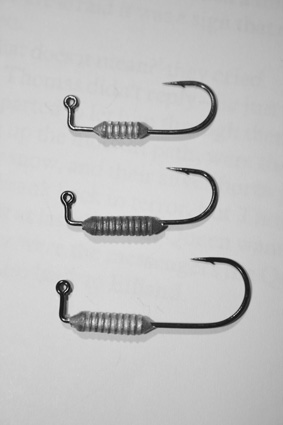
Hidden Weights in size 2 and 1 hooks are great. Use as light as possible for the conditions.
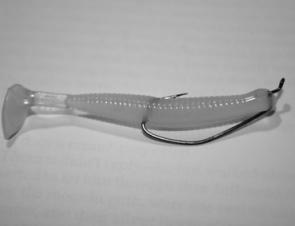
An Ecogear Grass Minnow rigged on a 1/0 Owner worm hook is the ideal light presentation when fishing plastics across the surface.
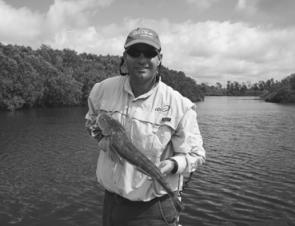
Flathead also love lightly-weighted lures. This fish was holding up on shallow weed.
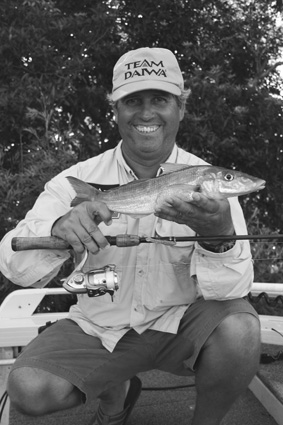
This lovely whiting took a 2” Gulp Shrimp rigged on a Tackle Tactics Hidden Weight.

Casting into heavy cover of any type needs nerves of steel and good reflexes.
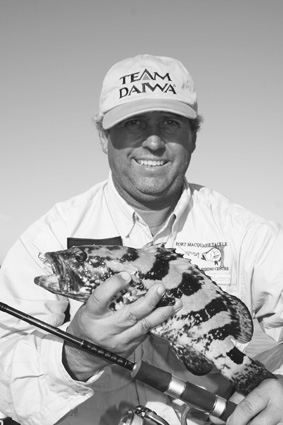
This black cod is a protected species and was released immediately after a few photos. It goes to show that light-weight tactics catch a variety of species.
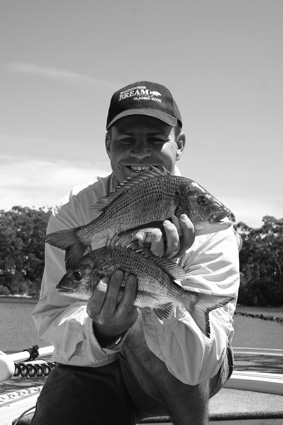
Two lovely bream specimens that snaffled light lures over the tops of oyster leases.

Feeding bream cannot resist an unweighted Ecogear Grass Minnow.
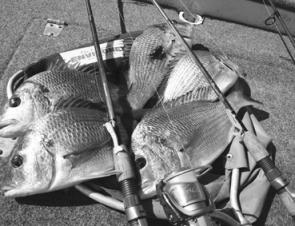
Any tournament angler would be very happy with this haul of bream taken with minimally-weighted lures.
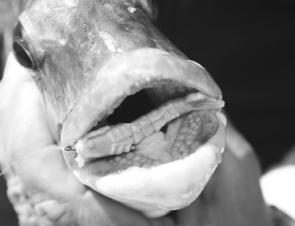
This old toothed bream loved the 2” Berkley Gulp Shrimp




